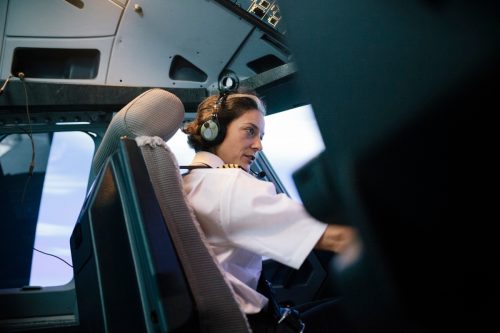United and American Are Now Making Passengers Do This for Certain Flights

As summer looms closer and closer, travelers are eager to book a flight and shake off the two years of uncertainty brought on by the COVID pandemic. But amid increased travel demand in the coming months, the aviation industry is still unprepared. An ongoing pilot shortage is putting many carriers in a precarious spot, and some are having to make major changes as a result. Read on to find out what American Airlines and United Airlines are now making you do for certain flights.
RELATED: Delta Just Made This Permanent Change for All Passengers, Starting Now.
There is a pilot shortage impacting U.S. airlines right now.

The U.S. is currently facing a major pilot shortage. The Regional Airline Association has estimated that half of all the pilots in this country are set to retire in the next 15 years, ABC News recently reported. According to Bloomberg, an Federal Aviation Administration (FAA) requirement that pilots retire once they turn 65 years old was already set to impact the aging industry, but when thousands of pilots accepted early requirement packages in 2020 as airlines tried to cut costs amid COVID shutdowns, the problem was further exacerbated.
“The pilot shortage for the industry is real and most airlines are simply not going to be able to realize their capacity plan because there simply aren’t enough pilots, at least not for the next five plus years,” United Airlines CEO Scott Kirby said during a recent earnings call.
Experts say the problem is more severe for regional carriers.

Regional carriers are feeling the negative effects of the pilot shortage more than major airlines. United’s regional partners have already grounded around 150 planes because of the shortage and will likely have to keep them out of use even as travel demand increases, ABC News reported. “The other really large airlines will also probably be able to attract enough pilots, but for anyone else, I just don’t think it’s mathematically possible to meet the pilot demand for the capacity plans that are out there,” Kirby explained.
According to AeroTime, pilots usually begin flying at a regional level before moving to mainline carriers. But as Bloomberg explained, the already strained industry is getting even more strained at the local level as larger carriers take pilots away from regional airlines earlier to hire to make up for mainline pilots retiring. “Larger airlines are able to recruit, but midsize and smaller airlines are having problems. Regional airlines, the airlines that operate the 50 to 75 seat airplanes that we see many airlines operate to small towns, they are really struggling and airlines have had to scale back or drop service to a lot of smaller communities,” Henry Harteveldt, president of travel analytics firm Atmosphere Research, told ABC News.
RELATED: For more travel news delivered straight to your inbox, sign up for our daily newsletter.
Some carriers are now making passengers use buses instead of planes to combat this.

As the pilot shortage continues to affect U.S. airlines—especially at a regional level—some carriers are trying a different service approach to lessen the impact. According to Bloomberg, both United and American have started replacing certain routes with buses instead of planes. The two airlines have signed contracts with Landline Co., a Colorado-based bus transit service, to transport passengers and their luggage on some shorter domestic routes.
United is already using Landline in Colorado, where it started its once-daily bus service from Denver to Breckenridge on March 11 and its four-times daily route to Fort Collins on April 1. And American is set to start bus service between its Philadelphia hub to the Lehigh Valley Airport (ABE) in Pennsylvania, and the Atlantic City International Airport (ACY) in New Jersey on June 3, according to Landline.
Passengers might still experience flight cuts because of the shortage.

The new airline bus routes aren’t a total fix, of course. Many airlines are also cutting future flights to try to alleviate major disruption from the pilot shortage. In early April, Alaska Airlines announced that it would be reducing 2 percent of its flights through June in order to prevent further last-minute cancellations and match its “current pilot capacity.”
Some regional carriers have recently axed flights as well. On April 18, Sun County Airlines announced that “due to the current pilot shortage,” it would be suspending all of its flights to Honolulu, Hawaii, for the rest of 2022, Newsweek reported. “This is the pivotal point,” Faye Malarkey Black, chief executive of the Regional Airline Association, told Bloomberg. “We have not seen this level of service loss since right after 9/11, when that crisis changed the fly-drive equation. I expect this bad situation to get worse before it gets better, no matter what we do.”
RELATED: American Is Cutting Flights From These 4 Major Cities, Starting May 1.